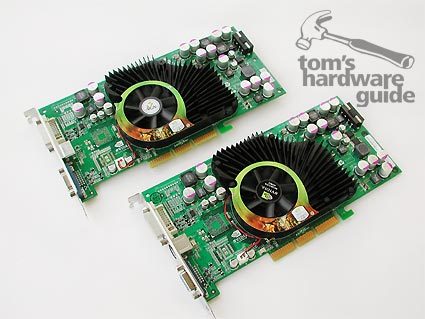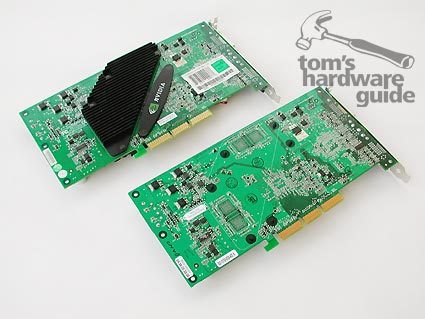GDDR-3 Memory: GeForce FX 5700 Ultra
NVIDIA GeForce FX5700 Ultra GDDR-3
A first cursory glance at the PCB of the new FX 5700 Ultra variant reveals no remarkable differences compared to the GDDR-2 model. The most obvious change is that the GDDR-3 model uses fewer memory modules. While the GDDR-2 card used 128Mbit chips, the GDDR-3 version features 256Mbit chips. Therefore the newer version requires only four modules, where the older one needed eight to offer 128 MB of video RAM. Note, however, that this reduction in parts is not an intrinsic characteristic of GDDR-3. Theoretically, NVIDIA could just as easily have equipped the old 5700U GDDR-2 model with four 256Mbit modules. But since these new memory modules are only available in sizes starting at 256Mbit, NVIDIA had no other choice.
The organisation of the chips has no effect on the bus width, however. The memory subsystem is still 128 bits wide. To counterbalance the negative impact of the new memory's higher latencies (and probably also to differentiate the new card from the previous model), NVIDIA decided to raise the memory frequency from 450 MHz (900 MHz DDR) to 475 MHz (950 MHz DDR). The core frequency of the NV36 GPU remains unchanged at 475 MHz, however.
The new (below) and old (above) models side by side. When looked at from the top, there is practically no way of telling the two apart.
Since the GDDR-3 card uses 256Mbit memory modules, it only needs four modules to reach 128 MB
Get Tom's Hardware's best news and in-depth reviews, straight to your inbox.
Current page: NVIDIA GeForce FX5700 Ultra GDDR-3
Prev Page What's New About GDDR-3? Next Page NVIDIA GeForce FX5700 Ultra GDDR-3, Continued
